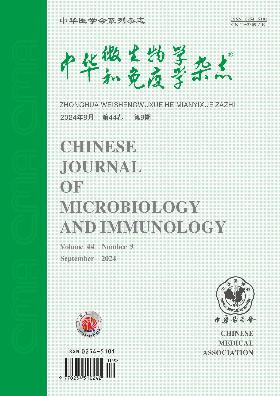Establishment of a database of in vitro combined drug efficacy against multi-drug resistant Gram-negative bacilli
Q4 Immunology and Microbiology
引用次数: 0
Abstract
Objective To study the synergistic and additive effects of commonly used antibiotics on multi-drug resistant Gram-negative bacilli and to establish a database of combined pharmacodynamics in vitro. Methods Seven antibiotics including fosfomycin (PHOS), levofloxacin (LEV), ceftazidime (CAZ), compound sulfamethoxazole (SMZ), piperacillin/tazobactam (TZP), cefoperazone/sulbactam (SCF) and imipenem (IMP) were selected and grouped into 21 drug pairs. Based on the results of extended spectrum β-lactamases (ESBLs) test and modified carbapenem inactivation method (mCIM), a total of 172 strains of multidrug-resistant Gram-negative bacilli were divided into four groups: 20 strains of carbapenem-resistant Klebsiella pneumoniae (group A), 50 strains of pan-resistant Acinetobacter baumannii (group B), 62 strains of ESBLs-producing Enterobacter (group C) and 40 strains of carbapenem-resistant Pseudomonas aeruginosa (group D). Chessboard dilution method was used to detect the in vitro combined efficacy of 21 drug pairs on drug-resistant bacteria from the four groups. Whonet 5.6 was used for statistical analysis. Results All 172 strains were single drug resistant to the seven antibiotics. Results of the combined drug efficacy test showed that no antagonism was found in the four groups. In group A, ten drug pairs, especially the combination of PHOS+ LEV (30%, 6/20), had synergistic effects and 14 showed partial synergistic effects, but no additive effect was detected. Synergistic effects, partial synergistic effects and additive effects were respectively achieved by 12, ten and three drug pairs in group B. The LEV+ SMZ combination had synergistic effects against 56% (28/50) of the strains, which was the highest among all combinations. There were 14, 17 and 16 drug pairs showing synergistic effects, partial synergistic effects and additive effects in group C, respectively, and the strongest synergistic effects were achieved by the IMP+ LEV combination (30.6%, 19/62). There were 12, 14 and 13 drug pairs having synergistic effects, partial synergistic effects and additive effects in group D, respectively, and the strongest synergistic effects were achieved by the IMP+ LEV combination (20%, 8/40). Conclusions The combined use of quinolones, carbapenems, sulfonamides and PHOS could have good synergistic effects against multi-drug-resistant gram-negative bacilli. Monitoring the in vitro combined efficacy before treatment would improve the accuracy of antibiotic use and is of great clinical value. Key words: Multi-drug resistance; Antibiotics; Gram-negative bacilli; Combined drug efficacy; Synergistic effect; Additive effect多药耐药革兰氏阴性杆菌体外联合用药疗效数据库的建立
目的研究常用抗生素对多重耐药革兰氏阴性杆菌的协同和加性作用,建立体外联合药效学数据库。方法选择磷霉素(PHOS)、左氧氟沙星(LEV)、头孢他啶(CAZ)、复方磺胺甲恶唑(SMZ)、哌拉西林/他唑巴坦(TZP)、头孢哌酮/舒巴坦(SCF)、亚胺培南(IMP)等7种抗生素,分为21对。根据广谱β-内酰胺酶(ESBLs)检测结果和改良碳青霉烯类失活法(mCIM),将172株多重耐药革兰氏阴性杆菌分为4组:20株耐碳青霉烯肺炎克雷伯菌(A组)、50株泛耐鲍曼不动杆菌(B组)、62株产esbls肠杆菌(C组)和40株耐碳青霉烯铜绿假单胞菌(D组)。采用棋盘稀释法检测21对药物对4组耐药菌的体外联合药效。采用Whonet 5.6进行统计分析。结果172株对7种抗生素均有单药耐药。联合药效试验结果显示,四组均未发现拮抗作用。A组有10对药物对具有协同作用,其中以PHOS+ LEV联合用药效果最显著(30%,6/20),有14对出现部分协同作用,但未发现加性效应。b组12对、10对和3对药物分别产生了协同效应、部分协同效应和加性效应,LEV+ SMZ联合对56%(28/50)的菌株产生了协同效应,在所有联合中效果最高。C组有14对、17对和16对药物分别表现出协同效应、部分协同效应和可加性效应,其中IMP+ LEV联合用药的协同效应最强(30.6%,19/62)。D组分别有12对、14对和13对药物具有协同作用、部分协同作用和可加性作用,其中IMP+ LEV联合用药的协同作用最强(20%,8/40)。结论喹诺酮类药物、碳青霉烯类药物、磺胺类药物和PHOS联合应用对多重耐药革兰氏阴性杆菌具有良好的协同作用。治疗前监测体外联合疗效可提高抗生素使用的准确性,具有重要的临床价值。关键词:多重耐药;抗生素;革兰氏阴性杆菌;联合用药疗效;协同效应;添加剂的影响
本文章由计算机程序翻译,如有差异,请以英文原文为准。
求助全文
约1分钟内获得全文
求助全文
来源期刊

中华微生物学和免疫学杂志
Immunology and Microbiology-Virology
CiteScore
0.50
自引率
0.00%
发文量
6906
期刊介绍:
Chinese Journal of Microbiology and Immunology established in 1981. It is one of the series of journal sponsored by Chinese Medical Association. The aim of this journal is to spread and exchange the scientific achievements and practical experience in order to promote the development of medical microbiology and immunology. Its main contents comprise academic thesis, brief reports, reviews, summaries, news of meetings, book reviews and trends of home and abroad in this field. The distinguishing feature of the journal is to give the priority to the reports on the research of basic theory, and take account of the reports on clinical and practical skills.
 求助内容:
求助内容: 应助结果提醒方式:
应助结果提醒方式:


